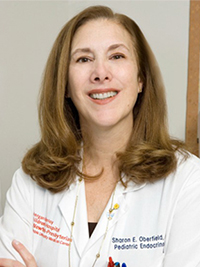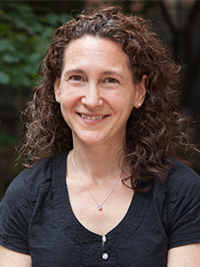NewYork-Presbyterian has established one of the first comprehensive research programs in New York to investigate the effects of endocrine-disrupting chemicals on the genitourinary system in newborns. This study is a collaborative effort among Sharon E. Oberfield, MD, Chief of Pediatric Endocrinology, Diabetes, and Metabolism, NewYork-Presbyterian Morgan Stanley Children’s Hospital and Columbia; Zoltan Antal, MD, Chief of Pediatric Endocrinology, NewYork-Presbyterian Komansky Children’s Hospital and Weill Cornell Medicine; and Julie Herbstman, PhD, ScM, an epidemiologist and Director of the Columbia Center for Children’s Environmental Health (CCCEH) in Environmental Health Sciences at Columbia Mailman School of Public Health.

Dr. Sharon Oberfield

Dr. Zoltan Antal

Dr. Julie Herbstman
Dr. Oberfield and Dr. Herbstman have extensive experience in this field of research through the CCCEH, which focuses on the impact of environmental chemicals, including endocrine-disruptors, on children. Dr. Antal is an expert in disorders of sexual differentiation and development, frequently partnering with pediatric urologists in the evaluation and care of boys with hypospadias.
“This project is very exciting to us because Dr. Herbstman and I have been thinking about the potential impact of environmental disruptors on various organ systems in the body for some time,” says Dr. Oberfield, who served as the scientific advisor for the CCCEH for many years. “With Dr. Antal’s expertise in sexual differentiation and development, this project integrates all of our interests.”
Hypospadias is among the most common congenital malformations, affecting approximately 1 in 150 live male births in the U.S. While the etiology of hypospadias is unknown, some 30 percent are associated with genetic syndromes, suggesting that non-genetic factors play an important role in the majority of hypospadias. As the Weill Cornell Medicine and Columbia researchers note, given the embryonic origin of external genitalia development, pregnancy is a critical period for risk of hypospadias.
“Generating knowledge from these studies can help guide both prenatal care to reduce environmental exposures and facilitate evaluations postnatally in ways we do not have available today. This work will provide background to develop new opportunities for prevention of a condition with lifelong impact.” — Dr. Sharon Oberfield
Endocrine-disrupting chemicals (EDC) are exogenous substances that interfere with normal homeostatic control or reproduction by altering hormone biosynthesis, metabolism, or action. One class of EDCs is environmental bisphenols, with bisphenol-a (BPA) the most widely recognized. This estrogen-like endocrine disruptor is associated with reproductive and neurodevelopmental deficits, particularly following in utero exposure. Although limited, there are studies which suggest that environmental bisphenols may be implicated in the development of urogenital malformations, including hypospadias. The Columbia and Weill Cornell Medicine investigators hypothesize in their proof-of-concept study that bisphenol levels measured in meconium will be higher in hypospadias cases compared to controls.
“Among the genitourinary abnormalities that children can be born with, hypospadias in boys is among the most common,” says Dr. Antal. “Every urologist and every pediatric endocrinologist will see a significant number of cases throughout their career and so in that respect, it is definitely an important topic. This subject is also important because we are talking about the potential exposure of newborns to endocrine-disrupting chemicals. Although the focus is on newborns, this is a very broad question. How are we all exposed to these endocrine-disrupting chemicals, and when do their effects become evident? In our study, we are challenging ourselves to understand the connection between certain exposures and outcomes. We're looking at the scientific merits of association but are mindful that this is only a small part of a bigger question.”
“It is important to elucidate the cause of hypospadias, particularly if it leads to an opportunity for prevention. Our study will have a small focus that will potentially open a broader world of information.” — Dr. Zoltan Antal
Over the next year, the researchers plan to meet with parents who give birth to boys across NewYork-Presbyterian campuses. The study will include boys with and without hypospadias. The researchers will ask families to take a short survey and provide their child’s meconium (first stool) sample, which would be analyzed for evidence of EDC exposure.
“We're going to measure the quantity of the environmental bisphenol levels in the meconium to compare the boys who have hypospadias findings, those who do not, and the differences in levels,” says Dr. Oberfield. “If that association can be reasonably made, then I think additional questions will be generated about mechanism of action and the source of the exposure.”
Establishing the bi-campus collaborative protocol will also enable training and research opportunities at Columbia and Weill Cornell Medicine. “We hope to expand this study on EDCs beyond phenols and hypospadias,” says Dr. Oberfield. “Leveraging the CCCEH’s strong and continuous NIH funding, this program will provide the basis for additional NIH-funded research proposals on EDCs and children’s genitourinary health.”
“A further benefit from this research is the opportunity to train future experts in this field,” says Dr. Antal. “By involving fellows on both of our campuses, they will gain expertise in this important area of study, which is a real strength of this study.”
“The collaboration of two major medical academic centers to perform research with the support of the NewYork-Presbyterian enterprise allows us the unique access to involving many more patients in this research,” adds Dr. Oberfield. “It formalizes collaborative teaching and research initiatives, and I’m very glad that we’re starting on this venture together.”



